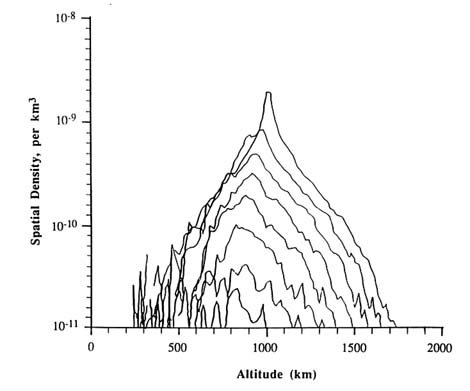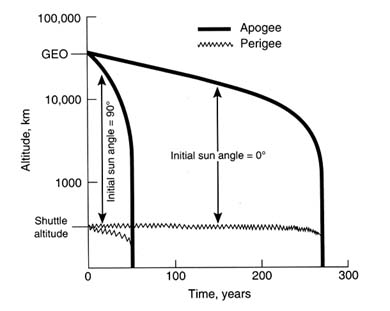There are many possible means of reducing the debris hazard to future space operations. These include actions taken as a spacecraft enters orbit (e.g., tethering rather than jettisoning lens caps and despin devices), during operations (e.g., reducing the amount of refuse ejected from crewed missions), and after its functional lifetime (e.g., depleting energy sources or moving the spacecraft into a disposal orbit). Some methods would cost very little, whereas others might be economically prohibitive for some missions. Their effectiveness also will vary, not only from method to method but also in how well a particular method will work in different orbital regions and with different space systems.
Methods to reduce the future growth in the debris population can be divided into two major categories: those that reduce only the short-term hazard and those that are also capable of reducing the long-term hazard. Measures that reduce the number of objects in orbit without reducing the total mass are effective only in diminishing the short-term hazard, because such measures do not reduce the total kinetic energy in orbit. It is this kinetic energy that constitutes the long-term collision hazard (Kessler and Loftus, 1994), so reductions in the long-term collision hazard require reducing the amount of mass in orbit. (This topic is discussed in greater detail in Chapter 8 .)
SAFEGUARDING THE PHYSICAL INTEGRITY OF ROCKET BODIES AND SPACECRAFTReducing the Creation of Debris from Explosions
Fragmentation debris makes up 42% of the cataloged space object population and probably a much larger fraction of the uncataloged population. Since there have been only two confirmed space object breakups to date due to collisions (both intentional military tests), the vast majority of this debris is believed to have been created in explosive breakups of spacecraft and rocket bodies. This population of debris spans all size ranges and is distributed widely, although concentrated near the orbits in which it was created. Figure 7-1 projects how a typical explosion in LEO (producing 300 cataloged objects) could moderately increase the spatial density of cataloged objects in orbits hundreds of kilometers above.

FIGURE 7-1 Predicted effect of satellite breakup at 1000 km. Top curve is initial spatial density distribution with altitude. Time interval between lower curves is 400 years. SOURCE: Kessler, 1991.
and below the breakup altitude. This increase in spatial density can persist for long periods of time; the higher the altitude, the longer will the spatial density remain elevated. Since explosions can produce a considerable amount of large and medium-sized debris with potentially long orbital lifetimes, reducing the creation of debris from explosions will clearly have a major effect in containing future growth in the debris hazard. A reduction in the frequency of explosions can be achieved by passivating spacecraft and rocket bodies.
Passivation of Spacecraft
Debris from spacecraft explosions makes up about 12.5 percent of the cataloged space object population. Spacecraft can explode both during and after their functional lifetime for a wide variety of reasons, including propellant tank explosions, thruster malfunctions, tank failures due to the impact of small debris, battery ruptures, accidentally induced high rotation rates, other degradations of the structure, or deliberate explosions. There are correspondingly many possible measures to prevent spacecraft breakups. There is no one single remedy, and there is probably no possible way to avoid all future spacecraft breakups: despite safeguards, a residual number of spacecraft breakups will continue to generate debris, if at a reduced level.
However, spacecraft designers can take a general system-level approach to prevent accidental spacecraft breakups. The approach is (1) to determine all potential sources of stored energy remaining on a spacecraft late in its active life; (2) for each source, to provide a method of dissipating the stored energy in a benign manner; and (3) to activate these means at the end of the spacecraft’s functional lifetime (i.e., “passivate” the spacecraft). Protecting the spacecraft from debris impact damage, as well as other methods to increase spacecraft survivability, can help ensure that the spacecraft is capable of carrying out passivation measures at its EOL.
The “passivation” approach described above can be applied to numerous spacecraft subsystems. For example, spacecraft batteries are sources of stored energy believed responsible for a few breakups. To prevent such breakups, designers can implement a battery management system that ensures that the batteries will be left in a completely discharged state at the end of the spacecraft’s functional lifetime and will be short-circuited to prevent recharging. Implementation of this system would prevent inadvertent overcharging, which can lead to battery rupture and potentially break up spacecraft. Another example of this approach would be to ensure that all residual propellants and stored pressurized gas in the spacecraft are vented at the end of the spacecraft’s
Reducing the Creation of Debris from Degradation
The products of spacecraft surface deterioration include paint flecks and other surface materials that come loose from a space object under the influence of the space environment. Very few of these items are large enough to be cataloged; the vast majority are small. The few cataloged objects believed to be released due to surface degradation have had high ratios of cross-sectional area to mass and have experienced relatively rapid orbital decay. The vast numbers of small particles released due to surface degradation are also suspected to have high ratios of cross-sectional area to mass and thus fairly short orbital lifetimes (as discussed in Chapter 3). However, since a typical paint fleck may have a mass of only 10-6 gram, the deterioration of even minor amounts of surface material can rapidly replenish the orbiting population. As discussed in Chapter 4, these particles can cause surface degradation and can also potentially damage unprotected spacecraft components such as optics, windows, and tethers.
Much has been learned from LDEF and other experiments about the
effect of the space environment on various substances; thermal coatings and treatments that reduce surface charge buildup and have other long-life properties are now generally available. Although spacecraft designers commonly avoid using paint or other surface materials that significantly deteriorate during the spacecraft’s functional lifetime, they generally do not require that the surface coatings survive intact long after the spacecraft’s functional lifetime. The situation is similar for rocket bodies, although in this case the surface materials may be required to remain intact in space only for a few hours or days (although they must survive in the often harsh environment of the launch pad for long periods of time). Education of spacecraft and rocket body designers about the hazards caused by surface degradation and the preventive measures available may be an inexpensive means of reducing the creation of this type of debris.
REDUCING THE CREATION OF DEBRIS FROM COLLISIONS
Two main approaches could theoretically be employed to reduce the long-term creation of debris from collisions. These are (1) to decrease the number of collisions by employing collision avoidance techniques or (2) to remove objects capable of causing collisions away from crowded orbital regions. (Limiting the number of objects in orbit without reducing mass is not sufficient to reduce the long-term potential for collisions, because such reductions do not affect the total kinetic energy in orbit available to cause collisions.) The problem with the first approach is that, as discussed in Chapter 6, current collision warning systems are ineffective, and the development of effective systems would be both technically challenging and costly. Even if an effective collision warning system were implemented, it would probably not be of use in preventing breakups of either nonfunctional spacecraft or other debris (because such objects are incapable of maneuvering to avoid a collision). Consequently, removing debris from crowded orbits may be the only practical alternative.
There are four techniques that can move debris from heavily trafficked orbits: (1) deorbiting (the deliberate, forced reentry of a space object into the Earth’s atmosphere by application of a retarding force, usually via a propulsion system) at EOL; (2) orbital lifetime reduction (accelerating the natural decay of spacecraft and other space objects to reduce the time that they remain in orbit) at EOL; (3) moving objects into less populated “disposal” orbits at the end of their functional lifetime; and (4) active removal of debris from orbit.
Deorbiting/Lifetime Reduction
Although breakup fragments outnumber all other types of orbital debris, rocket bodies and (to a lesser degree) spacecraft have by far the largest fraction of mass and cross-sectional area in orbit. Most collisions, therefore, will involve these objects. The abandonment of rocket bodies and spacecraft in Earth orbits—especially in long-lifetime orbits such as GEO, circular orbits higher than 800 km, some GTOs, and some Molniyatype orbits—greatly increases the long-term potential for future collision. Possible techniques for deorbiting or accelerating the decay of these objects include the use of retrograde propulsion, natural perturbing forces, and drag augmentation devices.
Retrograde propulsion burns can be performed with dedicated small rocket thrusters or, as previously discussed, through a depletion burn of excess on-board fuel with existing rockets. A retrograde burn can be used either (1) to achieve a controlled deorbit, in which the rocket body or spacecraft is directed to impact (or burn up during reentry) at a predetermined location over an ocean or another uninhabited area, or (2) to maneuver the rocket body or spacecraft to an orbit with a lower perigee, which will lead to a shorter orbital lifetime followed by uncontrolled atmospheric reentry and burnup.
Both spacecraft and rocket bodies may require some modifications to carry out deorbiting or lifetime reduction maneuvers. Some spacecraft may not have attitude or orbit control systems capable of performing EOL burns; such systems are necessary to execute reorbiting or lifetime reduction maneuvers. Rocket bodies may need enhanced batteries, attitude control, and command systems in order to remain functional long enough to perform the retarding thrust maneuver. (This is particularly important for rocket bodies in orbits near the spacecraft they have just released into orbit; such rockets must often perform the retarding thrust
Disposal Orbits
Deorbiting or meaningfully accelerating the orbital decay of spacecraft or rocket bodies from most widely used high-altitude orbital re-

FIGURE 7-4 Shuttle-launched LEO to GEO transfer stage lifetimes. Initial sun angle is the angle between the transfer stage’s original orbit and the sun. SOURCE: Loftus et al., 1992.
gions would be prohibitively costly. One means of removing objects from these regions is to reorbit them into ”disposal orbits” at the end of their functional lifetime. This leaves the objects in Earth orbit but removes them from regions where they would pose a direct collision hazard to functional spacecraft. Disposal orbits must typically be far enough from the initial orbit that orbital perturbations do not take the reorbited objects back through their initial orbit, although stable disposal orbits within widely used orbital regions have also been proposed. Reorbiting into a disposal orbit typically requires two propulsive burns at the end of a spacecraft’s or rocket body’s functional lifetime.
Disposal orbits have been proposed for GEO and other orbital regions, including higher LEO orbits and semisynchronous orbits. A considerable number of GEO spacecraft and some spacecraft in semisynchronous orbits have already performed reorbiting maneuvers to reduce the future debris hazard in those orbits. Spacecraft in the semisynchronous Global Positioning System constellation have performed end-of-life reorbiting maneuvers to disposal orbits from approximately 220 to 810 km above or 95 to 250 km below their initial orbits. In GEO, spacecraft owned by many nations and organizations have carried out
Active In-Orbit Debris Removal
The active removal of large debris (such as nonfunctional spacecraft and rocket bodies) from orbit has often been proposed as a means of reducing the debris hazard. The removal of large objects would require some kind of space vehicle dedicated to this purpose; all indications are that the cost of such a vehicle would be prohibitive, especially when the small reduction in the debris hazard that it could achieve is considered. (One study predicted a best-case cost of more than $15 million for each piece of debris in LEO removed, not counting the cost of developing an orbital maneuvering vehicle [Petro and Ashley, 1989].) Even ingenious schemes involving the use of tethers to deorbit large objects would likely be very costly.
A number of on-orbit active removal schemes for small debris also have been proposed, including the removal of small debris with “debris sweepers” (large foam balls or braking foils that impact with smaller
debris) and the ground- or space-based laser evaporation of debris surface material to deorbit small debris. The sweeper scheme seems technically difficult, demonstrably inefficient, hazardous to functional spacecraft, and risks producing more small objects than it eliminates. The laser concept, although interesting, requires costly new technology, and its feasibility has not yet been proven. In general, there is currently no technology able to remove small debris efficiently, and any foreseeable schemes look very costly.
